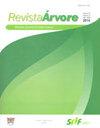INFLUENCE OF THE TIMBER ELASTIC MODULUS ON THE GEOMETRIC NONLINEAR STRUCTURAL ANALYSIS OF TRUSS ARCHES
IF 0.8
4区 农林科学
Q4 FORESTRY
引用次数: 0
Abstract
ABSTRACT In this work, it was numerically evaluated the influence of the modulus of elasticity parallel to the wood grain on the stability of trussed arches considering a nonlinear geometric analysis based on the Finite Element Method (FEM). This approach was carried out according to a positional formulation of the FEM, considering the structural nodes as main variables of the nonlinear equations system, whose resolution was obtained using the Newton-Raphson method. Altogether, seven arch models were evaluated, consisting of coniferous and hardwoods, with properties defined according to the strength classes of the Brazilian standard ABNT NBR 7190. The subroutines were written in MATLAB to solve the system of nonlinear equations and perform the analysis, including the graphical representation of the results and configurations of the trussed arch. Internal loads and displacements were obtained, in addition to the instability loads of the trussed arches. It was found that the instability load of the arch made with the stiffest hardwood (D60) was approximately equal to 700% of the instability load of the C20 coniferous class and equivalent to 257.8% of the D20 hardwood class-related load. It was verified that the modulus of elasticity significantly influences the nonlinear geometric behavior of the timber trussed arch. Furthermore, the nonlinear geometric analysis allowed calculating more accurate parameters and the verification of the stability of the structural system.木材弹性模量对桁架拱几何非线性结构分析的影响
本文采用基于有限元的非线性几何分析方法,对平行于木纹的弹性模量对桁架拱稳定性的影响进行了数值计算。该方法基于有限元的位置表达式,将结构节点作为非线性方程组的主要变量,采用牛顿-拉夫逊方法求解。总共评估了七种拱门模型,包括针叶树和硬木,其性能根据巴西标准ABNT NBR 7190的强度等级定义。在MATLAB中编写了求解非线性方程组的子程序并进行了分析,包括结果的图形表示和桁架拱的构型。除了桁架拱的失稳载荷外,还获得了内部载荷和位移。结果表明,最硬硬木(D60)制成的拱的失稳荷载约等于C20针叶树类失稳荷载的700%,相当于D20硬木类失稳荷载的257.8%。验证了弹性模量对木桁架拱的非线性几何性能有显著影响。此外,非线性几何分析可以计算更精确的参数和验证结构系统的稳定性。
本文章由计算机程序翻译,如有差异,请以英文原文为准。
求助全文
约1分钟内获得全文
求助全文
来源期刊

Revista Arvore
FORESTRY-
CiteScore
1.00
自引率
0.00%
发文量
32
审稿时长
4-8 weeks
期刊介绍:
A Revista Árvore é um veículo de comunicação científica da Sociedade de Investigações Florestais – SIF. O jornal é de acesso gratuito, revisado por pares, que publica bimestralmente trabalhos científicos originais no campo da Ciência Florestal. As áreas temáticas para publicação são: Ambiência e Conservação da Natureza, Manejo Florestal, Silvicultura e Tecnologia da Madeira e Utilização de Produtos Florestais.
A política editorial visa manter alta conduta ética em relação à publicação e aos seus funcionários, rigor na qualidade dos artigos científicos, seleção de revisores qualificados, respeito profissional aos autores e processo de tomada de decisão imparcial. A Revista Árvore publica artigos apenas em inglês.
Artigos de revisão podem ser publicados se houver uma discussão relevante resumindo o estado da arte sobre o assunto. A revisão estrita da literatura não é aceita.
 求助内容:
求助内容: 应助结果提醒方式:
应助结果提醒方式:


